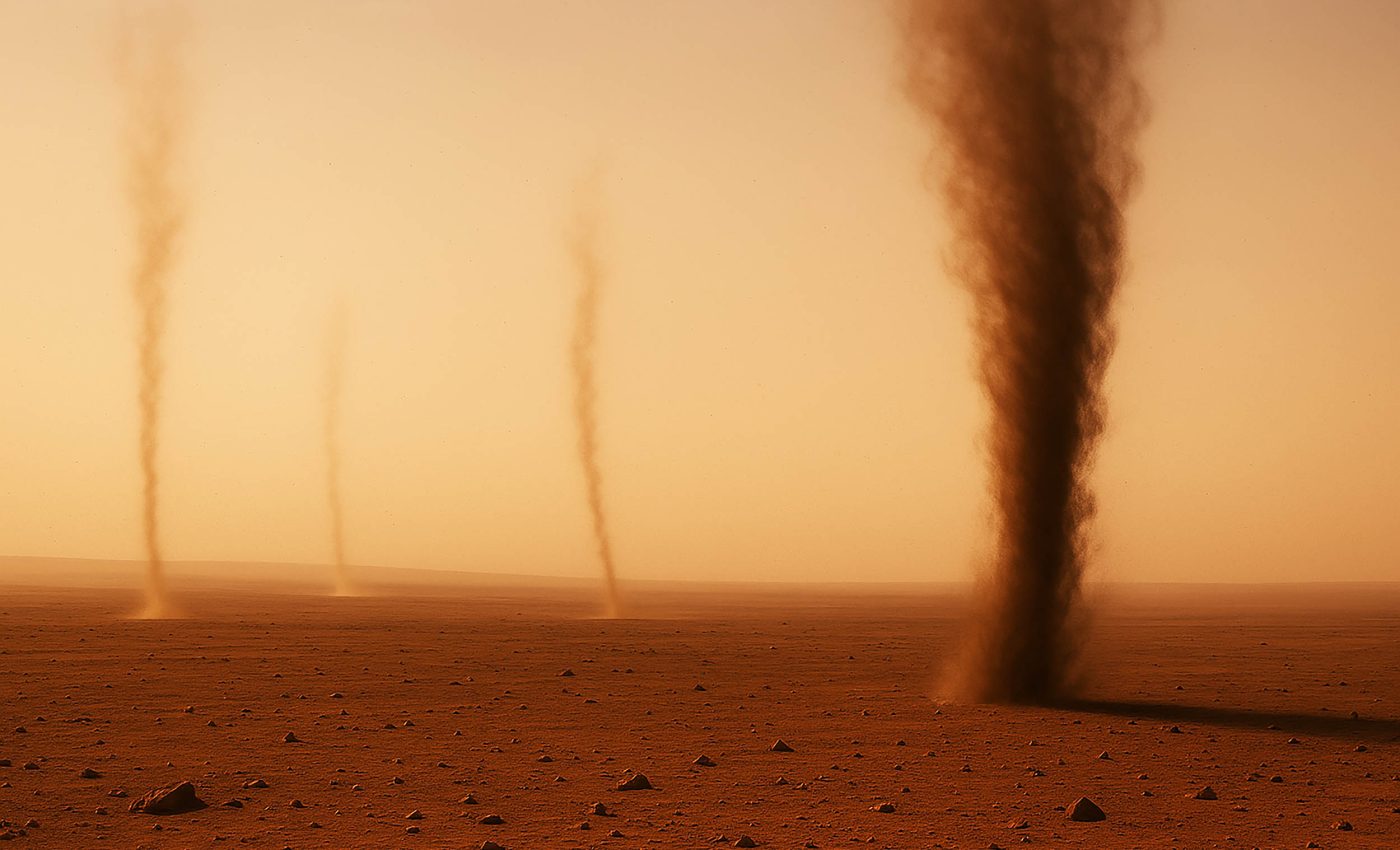
Right place, right time: Mars rover captures dust devils 'eating' each other
Dust devils are not only whipping up dust on Mars – they’re revealing new secrets about the planet’s atmosphere.
In a recent video, NASA’s Perseverance rover recorded a rare and spectacular scene on the Red Planet: a big dust devil that engulfed a small one.
The video was recorded as Perseverance was navigating the western rim of Jezero Crater, more precisely in a region known as Witch Hazel Hill.
The rover’s navigation camera took a series of shots from about 0.6 miles (1 kilometer) away, and created a short video by stitching together the images. The footage demonstrates an encounter of several dust devils.
One of them, approximately 210 feet (65 meters) wide, swept over another, smaller one that was just 16 feet (5 meters) wide. In the background, two other devils swirl across the Martian landscape.
These whirling mini-tornadoes are not only stunning, they’re also crucial to figuring out how Martian weather behaves.
Researchers from NASA’s Jet Propulsion Laboratory (JPL) in Southern California and the Space Science Institute in Colorado are behind this ongoing observation campaign.
Fiendish mini-twisters on Mars
“Convective vortices – aka dust devils – can be rather fiendish. These mini-twisters wander the surface of Mars, picking up dust as they go and lowering the visibility in their immediate area,” said Mark Lemmon, a Perseverance scientist.
“If two dust devils happen upon each other, they can either obliterate one another or merge, with the stronger one consuming the weaker.”

This latest video was part of an imaging experiment designed to study atmospheric conditions.
While unpredictable, dust devils are a common sight on Mars, especially around Jezero Crater. They help shape the Martian weather and are a key factor in distributing dust across the planet.
How dust devils form
Dust devils occur when warm air near the surface rises through cooler air above. As the warm air lifts, cooler air rushes in to replace it.
That horizontal movement of air begins to spin, and once the motion turns vertical, the column intensifies – much like a figure skater spinning faster when the arms are pulled inward. Dust is swept into the spinning air, and a dust devil comes to life.
“Dust devils play a significant role in Martian weather patterns,” said Katie Stack Morgan, project scientist for the Perseverance rover.
“Dust devil study is important because these phenomena indicate atmospheric conditions, such as prevailing wind directions and speed, and are responsible for about half the dust in the Martian atmosphere.”
History of Martian dust devil sightings
Perseverance has been no stranger to these whirlwinds. Since its landing in 2021, the rover has caught several on camera, including a particularly impressive scene on September 27, 2021.
On that day, a cluster of dust devils danced across the crater floor, and Perseverance’s SuperCam microphone even captured the eerie sound of one.
Mars missions have long had a fascination with these weather events.
NASA’s Viking orbiters were the first to photograph dust devils from space in the 1970s. In the 1990s, the Pathfinder mission became the first to record one from the surface.
Later, the Spirit and Opportunity rovers captured several dusty spirals, and the Curiosity rover continues to see them as it explores Mount Sharp in Gale Crater.
Timing is everything
Recording one of these events on film requires waiting – and a little luck. Scientists can’t anticipate where or when dust devils will form. So Perseverance often patrols the horizon, hoping for a peek.
As the team has gathered more data over time, they have started to see patterns in the behavior of dust devils, like hour-of-day or direction-of-travel patterns, that help predict where and when it is best to capture images of one.
“If you feel bad for the little devil in our latest video, it may give you some solace to know the larger perpetrator most likely met its own end a few minutes later,” said Lemmon. “Dust devils on Mars only last about 10 minutes.”
Though short-lived, these dusty whirlwinds are proving to be long on scientific value. Each sighting helps researchers build a better picture of Mars’s dynamic atmosphere and the role that dust plays in shaping the planet’s climate.
—–
Click here to see a video of one dust devil “eating” another one.
—–
Like what you read? Subscribe to our newsletter for engaging articles, exclusive content, and the latest updates.
Check us out on EarthSnap, a free app brought to you by Eric Ralls and Earth.com.
—–













